Time Series and Forecasting
VerifiedAdded on 2023/06/15
|14
|2364
|278
AI Summary
This article discusses the sales forecast methods, autocorrelations, and regression analysis in time series and forecasting. The data on average monthly rainfall in Malaysia for the 9-year period from 2007 to 2015 has been collected for this study. The analysis has been conducted using the statistical software SPSS version 20.
Contribute Materials
Your contribution can guide someone’s learning journey. Share your
documents today.
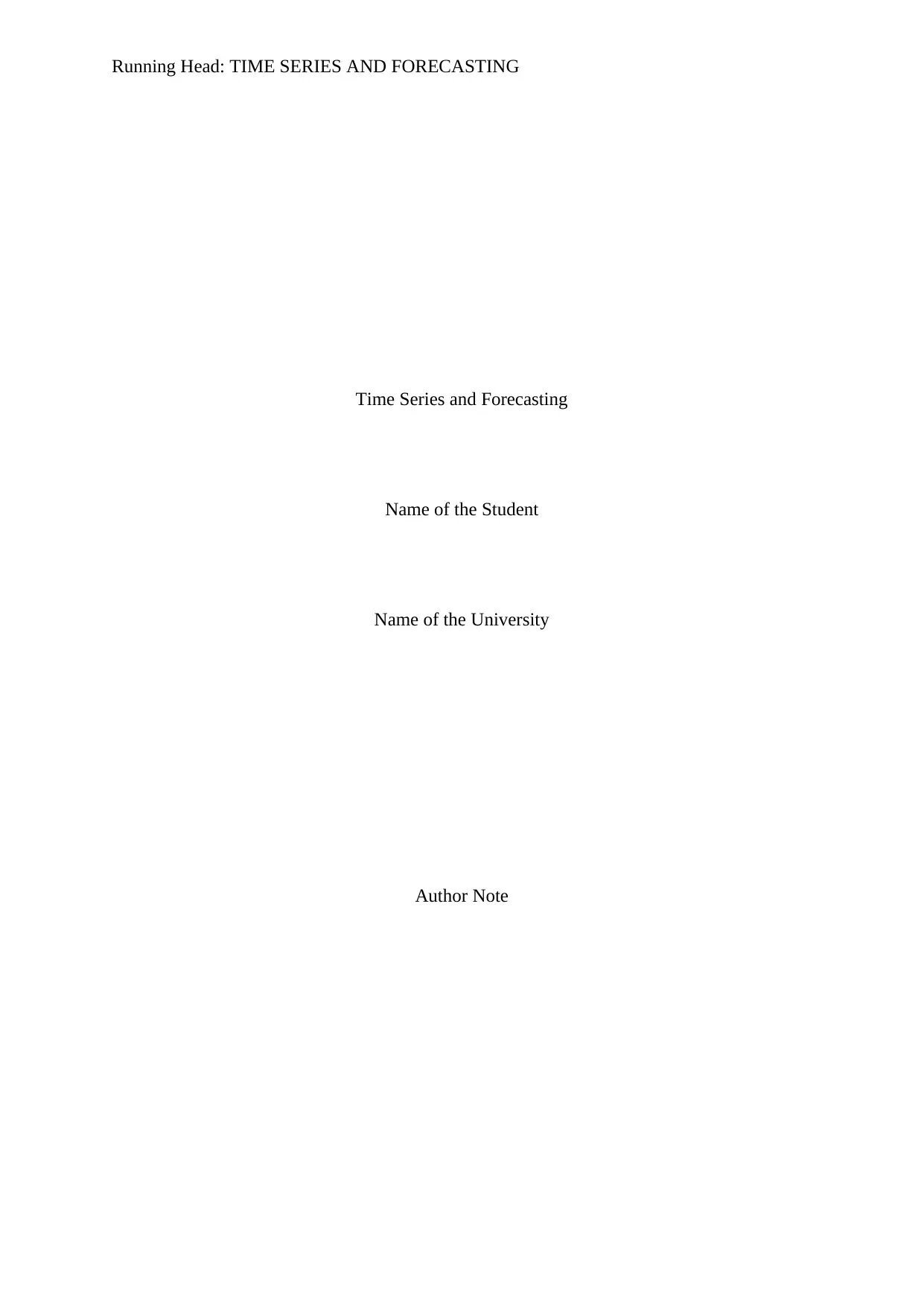
Running Head: TIME SERIES AND FORECASTING
Time Series and Forecasting
Name of the Student
Name of the University
Author Note
Time Series and Forecasting
Name of the Student
Name of the University
Author Note
Secure Best Marks with AI Grader
Need help grading? Try our AI Grader for instant feedback on your assignments.
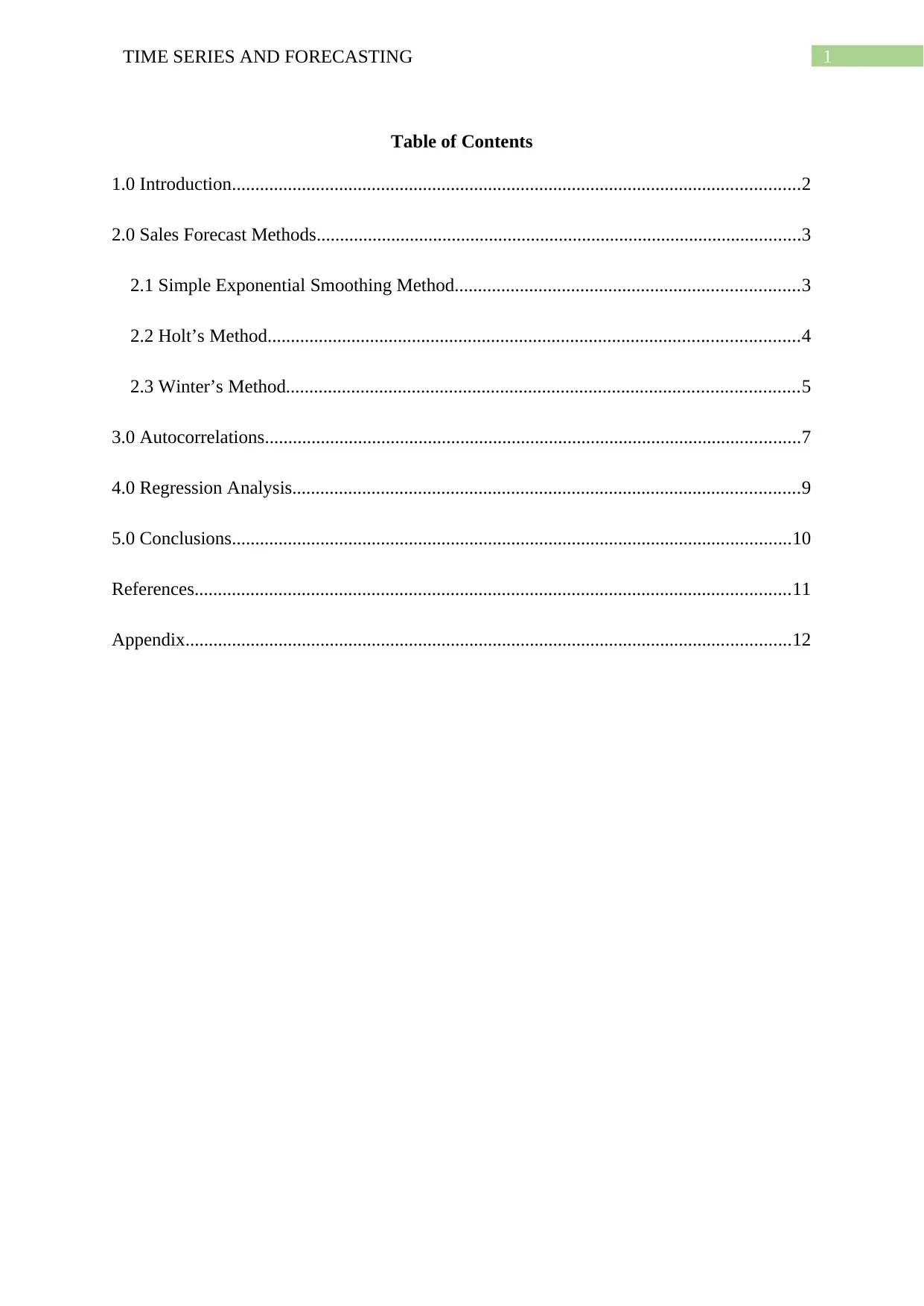
1TIME SERIES AND FORECASTING
Table of Contents
1.0 Introduction..........................................................................................................................2
2.0 Sales Forecast Methods........................................................................................................3
2.1 Simple Exponential Smoothing Method..........................................................................3
2.2 Holt’s Method..................................................................................................................4
2.3 Winter’s Method..............................................................................................................5
3.0 Autocorrelations...................................................................................................................7
4.0 Regression Analysis.............................................................................................................9
5.0 Conclusions........................................................................................................................10
References................................................................................................................................11
Appendix..................................................................................................................................12
Table of Contents
1.0 Introduction..........................................................................................................................2
2.0 Sales Forecast Methods........................................................................................................3
2.1 Simple Exponential Smoothing Method..........................................................................3
2.2 Holt’s Method..................................................................................................................4
2.3 Winter’s Method..............................................................................................................5
3.0 Autocorrelations...................................................................................................................7
4.0 Regression Analysis.............................................................................................................9
5.0 Conclusions........................................................................................................................10
References................................................................................................................................11
Appendix..................................................................................................................................12
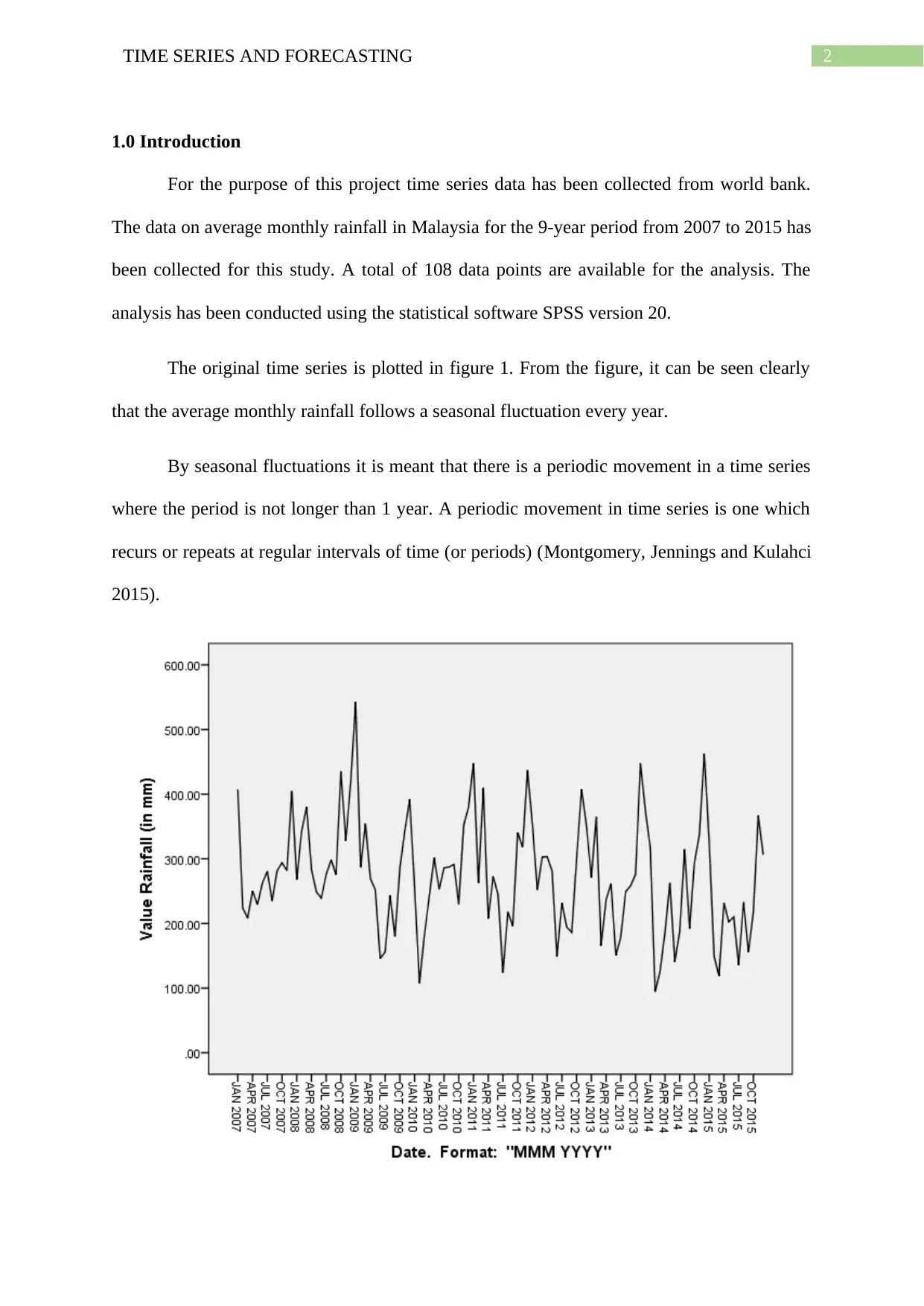
2TIME SERIES AND FORECASTING
1.0 Introduction
For the purpose of this project time series data has been collected from world bank.
The data on average monthly rainfall in Malaysia for the 9-year period from 2007 to 2015 has
been collected for this study. A total of 108 data points are available for the analysis. The
analysis has been conducted using the statistical software SPSS version 20.
The original time series is plotted in figure 1. From the figure, it can be seen clearly
that the average monthly rainfall follows a seasonal fluctuation every year.
By seasonal fluctuations it is meant that there is a periodic movement in a time series
where the period is not longer than 1 year. A periodic movement in time series is one which
recurs or repeats at regular intervals of time (or periods) (Montgomery, Jennings and Kulahci
2015).
1.0 Introduction
For the purpose of this project time series data has been collected from world bank.
The data on average monthly rainfall in Malaysia for the 9-year period from 2007 to 2015 has
been collected for this study. A total of 108 data points are available for the analysis. The
analysis has been conducted using the statistical software SPSS version 20.
The original time series is plotted in figure 1. From the figure, it can be seen clearly
that the average monthly rainfall follows a seasonal fluctuation every year.
By seasonal fluctuations it is meant that there is a periodic movement in a time series
where the period is not longer than 1 year. A periodic movement in time series is one which
recurs or repeats at regular intervals of time (or periods) (Montgomery, Jennings and Kulahci
2015).

3TIME SERIES AND FORECASTING
2.0 Sales Forecast Methods
2.1 Simple Exponential Smoothing Method
C.C. Holt first suggested this this method of forecasting in 1958. This method is
usually used to forecast values which do not have any systematic trend and follows non-
seasonal time series data. In reality, the data that are obtained do not usually follow any
seasonal pattern. The non-seasonal effects are measurable and can be removed and thus, the
developed and revised model will be stationary.
In exponential smoothing technique of forecasting, data which is older is given lesser
priority and the data which are new are given more priority. This method is also known as
averaging and is used to forecast values for a shorter term (Ramtirthkar et al. 2016).
The forecast using the simple exponential smoothing method for the year 2016 is
given in table 2.1.
Table 2.1: Forecast Exponential Smoothing
Model Jan
2016
Feb
2016
Mar
2016
Apr
2016
May
2016
Jun
2016
Jul
2016
Aug
2016
Sep
2016
Oct
2016
Nov
2016
Dec
2016
Rainfall
(in
mm)-
Model_
1
Foreca
st
255.5
8
255.5
8
255.5
8
255.5
8
255.5
8
255.5
8
255.5
8
255.5
8
255.5
8
255.5
8
255.5
8
255.5
8
UCL 429.4
6
429.5
5
429.6
4
429.7
3
429.8
2
429.9
1
430.0
0
430.0
9
430.1
8
430.2
7
430.3
6
430.4
5
LCL 81.70 81.61 81.52 81.43 81.34 81.25 81.16 81.07 80.98 80.89 80.80 80.71
2.0 Sales Forecast Methods
2.1 Simple Exponential Smoothing Method
C.C. Holt first suggested this this method of forecasting in 1958. This method is
usually used to forecast values which do not have any systematic trend and follows non-
seasonal time series data. In reality, the data that are obtained do not usually follow any
seasonal pattern. The non-seasonal effects are measurable and can be removed and thus, the
developed and revised model will be stationary.
In exponential smoothing technique of forecasting, data which is older is given lesser
priority and the data which are new are given more priority. This method is also known as
averaging and is used to forecast values for a shorter term (Ramtirthkar et al. 2016).
The forecast using the simple exponential smoothing method for the year 2016 is
given in table 2.1.
Table 2.1: Forecast Exponential Smoothing
Model Jan
2016
Feb
2016
Mar
2016
Apr
2016
May
2016
Jun
2016
Jul
2016
Aug
2016
Sep
2016
Oct
2016
Nov
2016
Dec
2016
Rainfall
(in
mm)-
Model_
1
Foreca
st
255.5
8
255.5
8
255.5
8
255.5
8
255.5
8
255.5
8
255.5
8
255.5
8
255.5
8
255.5
8
255.5
8
255.5
8
UCL 429.4
6
429.5
5
429.6
4
429.7
3
429.8
2
429.9
1
430.0
0
430.0
9
430.1
8
430.2
7
430.3
6
430.4
5
LCL 81.70 81.61 81.52 81.43 81.34 81.25 81.16 81.07 80.98 80.89 80.80 80.71
Paraphrase This Document
Need a fresh take? Get an instant paraphrase of this document with our AI Paraphraser
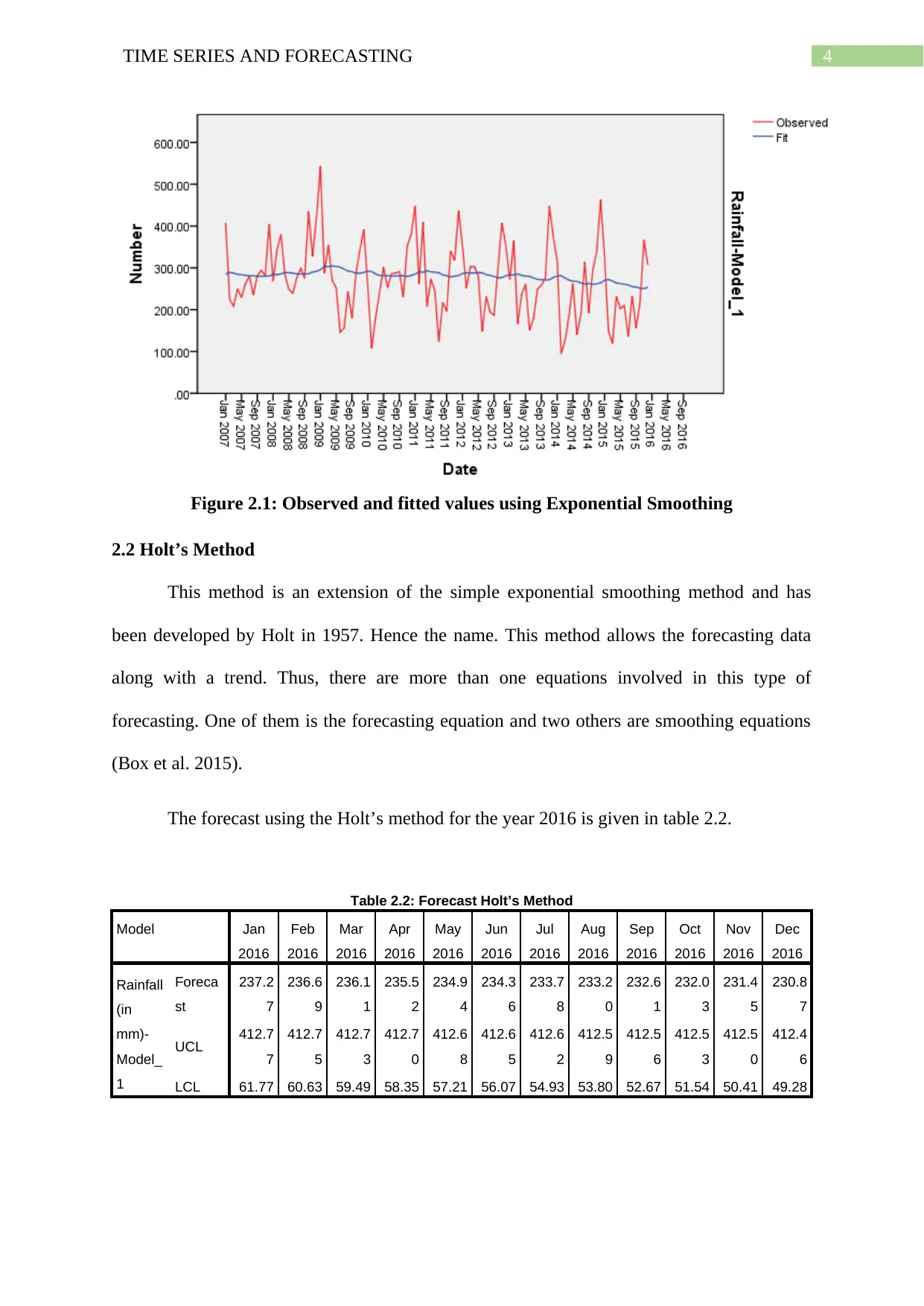
4TIME SERIES AND FORECASTING
Figure 2.1: Observed and fitted values using Exponential Smoothing
2.2 Holt’s Method
This method is an extension of the simple exponential smoothing method and has
been developed by Holt in 1957. Hence the name. This method allows the forecasting data
along with a trend. Thus, there are more than one equations involved in this type of
forecasting. One of them is the forecasting equation and two others are smoothing equations
(Box et al. 2015).
The forecast using the Holt’s method for the year 2016 is given in table 2.2.
Table 2.2: Forecast Holt’s Method
Model Jan
2016
Feb
2016
Mar
2016
Apr
2016
May
2016
Jun
2016
Jul
2016
Aug
2016
Sep
2016
Oct
2016
Nov
2016
Dec
2016
Rainfall
(in
mm)-
Model_
1
Foreca
st
237.2
7
236.6
9
236.1
1
235.5
2
234.9
4
234.3
6
233.7
8
233.2
0
232.6
1
232.0
3
231.4
5
230.8
7
UCL 412.7
7
412.7
5
412.7
3
412.7
0
412.6
8
412.6
5
412.6
2
412.5
9
412.5
6
412.5
3
412.5
0
412.4
6
LCL 61.77 60.63 59.49 58.35 57.21 56.07 54.93 53.80 52.67 51.54 50.41 49.28
Figure 2.1: Observed and fitted values using Exponential Smoothing
2.2 Holt’s Method
This method is an extension of the simple exponential smoothing method and has
been developed by Holt in 1957. Hence the name. This method allows the forecasting data
along with a trend. Thus, there are more than one equations involved in this type of
forecasting. One of them is the forecasting equation and two others are smoothing equations
(Box et al. 2015).
The forecast using the Holt’s method for the year 2016 is given in table 2.2.
Table 2.2: Forecast Holt’s Method
Model Jan
2016
Feb
2016
Mar
2016
Apr
2016
May
2016
Jun
2016
Jul
2016
Aug
2016
Sep
2016
Oct
2016
Nov
2016
Dec
2016
Rainfall
(in
mm)-
Model_
1
Foreca
st
237.2
7
236.6
9
236.1
1
235.5
2
234.9
4
234.3
6
233.7
8
233.2
0
232.6
1
232.0
3
231.4
5
230.8
7
UCL 412.7
7
412.7
5
412.7
3
412.7
0
412.6
8
412.6
5
412.6
2
412.5
9
412.5
6
412.5
3
412.5
0
412.4
6
LCL 61.77 60.63 59.49 58.35 57.21 56.07 54.93 53.80 52.67 51.54 50.41 49.28
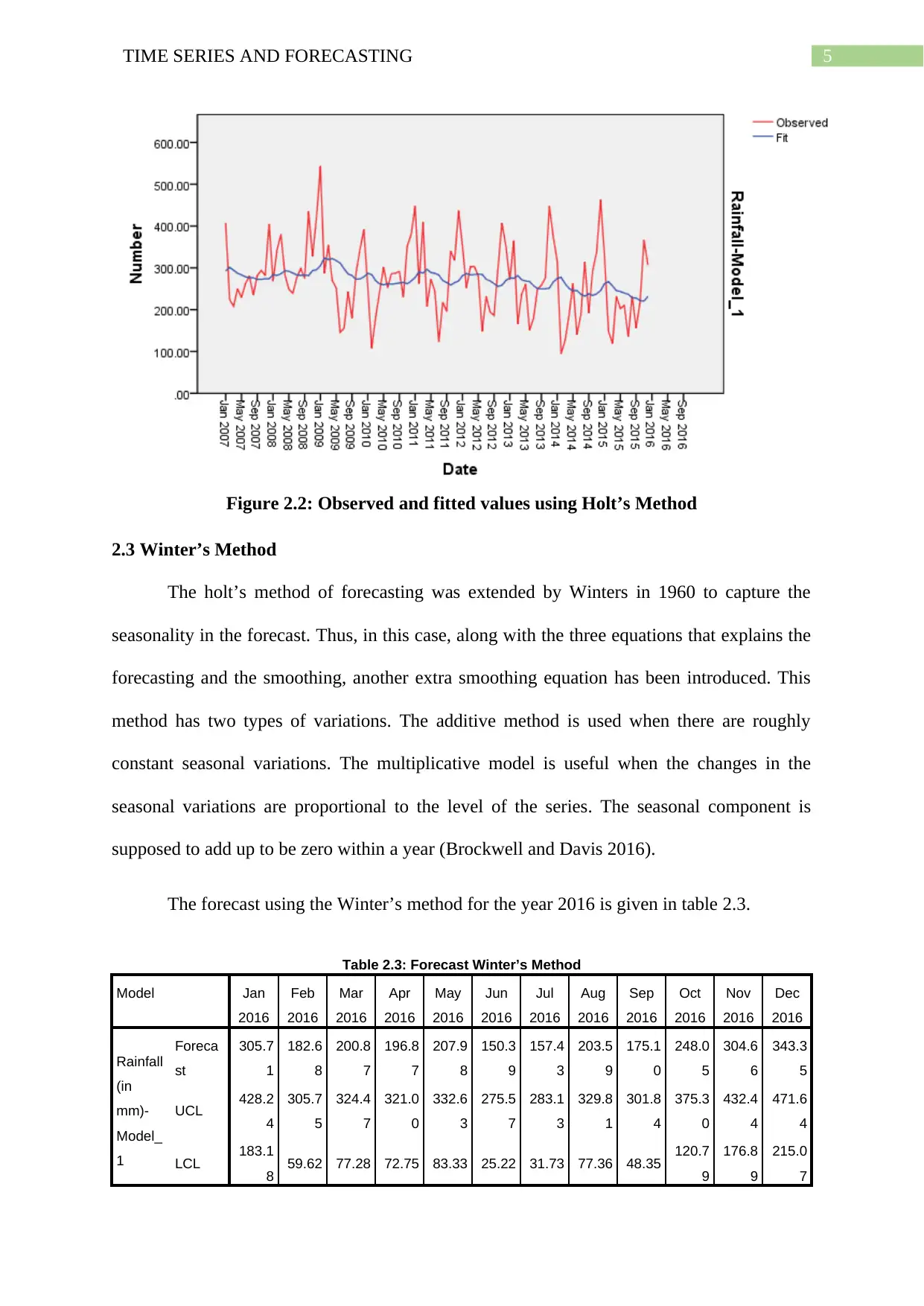
5TIME SERIES AND FORECASTING
Figure 2.2: Observed and fitted values using Holt’s Method
2.3 Winter’s Method
The holt’s method of forecasting was extended by Winters in 1960 to capture the
seasonality in the forecast. Thus, in this case, along with the three equations that explains the
forecasting and the smoothing, another extra smoothing equation has been introduced. This
method has two types of variations. The additive method is used when there are roughly
constant seasonal variations. The multiplicative model is useful when the changes in the
seasonal variations are proportional to the level of the series. The seasonal component is
supposed to add up to be zero within a year (Brockwell and Davis 2016).
The forecast using the Winter’s method for the year 2016 is given in table 2.3.
Table 2.3: Forecast Winter’s Method
Model Jan
2016
Feb
2016
Mar
2016
Apr
2016
May
2016
Jun
2016
Jul
2016
Aug
2016
Sep
2016
Oct
2016
Nov
2016
Dec
2016
Rainfall
(in
mm)-
Model_
1
Foreca
st
305.7
1
182.6
8
200.8
7
196.8
7
207.9
8
150.3
9
157.4
3
203.5
9
175.1
0
248.0
5
304.6
6
343.3
5
UCL 428.2
4
305.7
5
324.4
7
321.0
0
332.6
3
275.5
7
283.1
3
329.8
1
301.8
4
375.3
0
432.4
4
471.6
4
LCL 183.1
8 59.62 77.28 72.75 83.33 25.22 31.73 77.36 48.35 120.7
9
176.8
9
215.0
7
Figure 2.2: Observed and fitted values using Holt’s Method
2.3 Winter’s Method
The holt’s method of forecasting was extended by Winters in 1960 to capture the
seasonality in the forecast. Thus, in this case, along with the three equations that explains the
forecasting and the smoothing, another extra smoothing equation has been introduced. This
method has two types of variations. The additive method is used when there are roughly
constant seasonal variations. The multiplicative model is useful when the changes in the
seasonal variations are proportional to the level of the series. The seasonal component is
supposed to add up to be zero within a year (Brockwell and Davis 2016).
The forecast using the Winter’s method for the year 2016 is given in table 2.3.
Table 2.3: Forecast Winter’s Method
Model Jan
2016
Feb
2016
Mar
2016
Apr
2016
May
2016
Jun
2016
Jul
2016
Aug
2016
Sep
2016
Oct
2016
Nov
2016
Dec
2016
Rainfall
(in
mm)-
Model_
1
Foreca
st
305.7
1
182.6
8
200.8
7
196.8
7
207.9
8
150.3
9
157.4
3
203.5
9
175.1
0
248.0
5
304.6
6
343.3
5
UCL 428.2
4
305.7
5
324.4
7
321.0
0
332.6
3
275.5
7
283.1
3
329.8
1
301.8
4
375.3
0
432.4
4
471.6
4
LCL 183.1
8 59.62 77.28 72.75 83.33 25.22 31.73 77.36 48.35 120.7
9
176.8
9
215.0
7
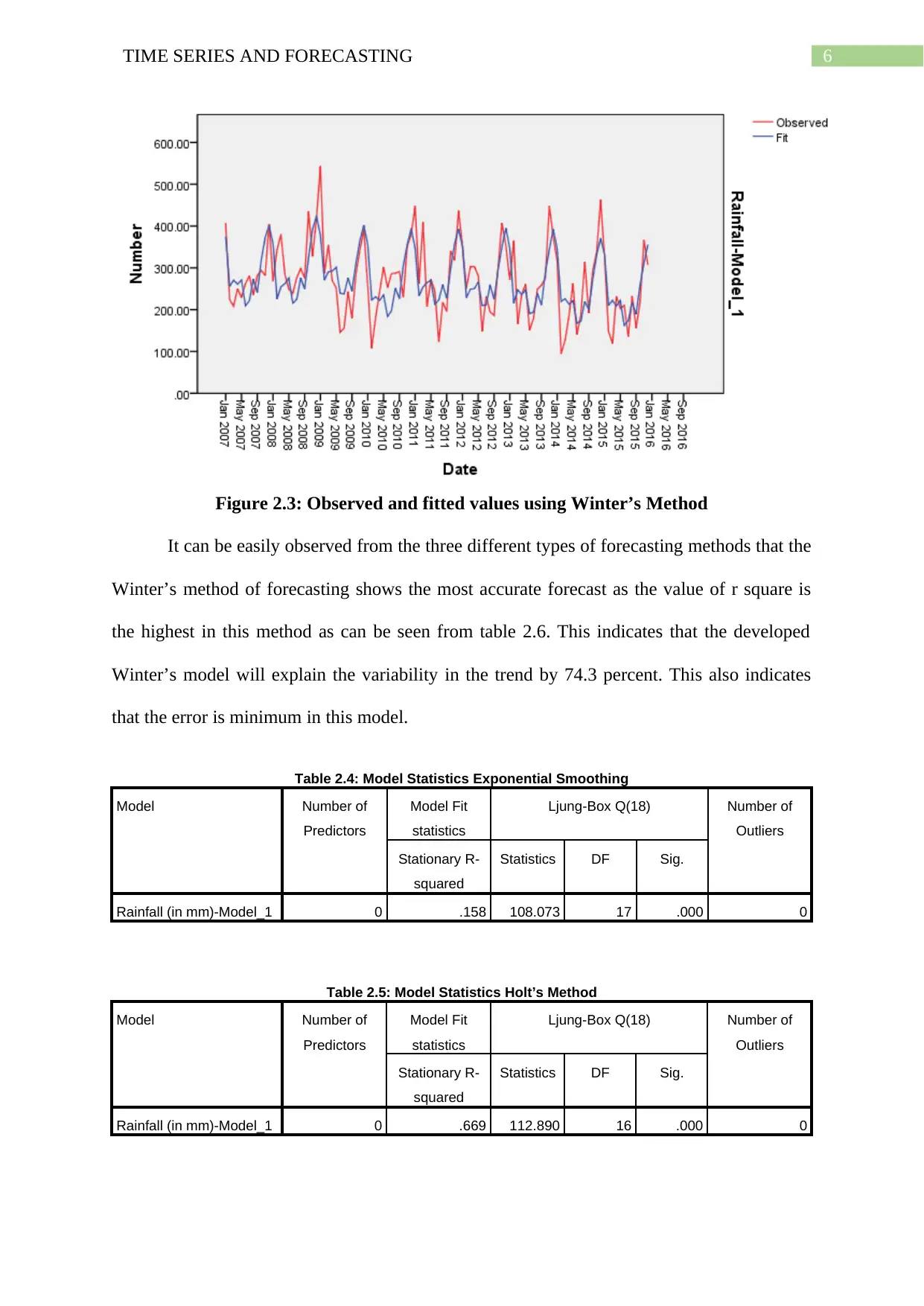
6TIME SERIES AND FORECASTING
Figure 2.3: Observed and fitted values using Winter’s Method
It can be easily observed from the three different types of forecasting methods that the
Winter’s method of forecasting shows the most accurate forecast as the value of r square is
the highest in this method as can be seen from table 2.6. This indicates that the developed
Winter’s model will explain the variability in the trend by 74.3 percent. This also indicates
that the error is minimum in this model.
Table 2.4: Model Statistics Exponential Smoothing
Model Number of
Predictors
Model Fit
statistics
Ljung-Box Q(18) Number of
Outliers
Stationary R-
squared
Statistics DF Sig.
Rainfall (in mm)-Model_1 0 .158 108.073 17 .000 0
Table 2.5: Model Statistics Holt’s Method
Model Number of
Predictors
Model Fit
statistics
Ljung-Box Q(18) Number of
Outliers
Stationary R-
squared
Statistics DF Sig.
Rainfall (in mm)-Model_1 0 .669 112.890 16 .000 0
Figure 2.3: Observed and fitted values using Winter’s Method
It can be easily observed from the three different types of forecasting methods that the
Winter’s method of forecasting shows the most accurate forecast as the value of r square is
the highest in this method as can be seen from table 2.6. This indicates that the developed
Winter’s model will explain the variability in the trend by 74.3 percent. This also indicates
that the error is minimum in this model.
Table 2.4: Model Statistics Exponential Smoothing
Model Number of
Predictors
Model Fit
statistics
Ljung-Box Q(18) Number of
Outliers
Stationary R-
squared
Statistics DF Sig.
Rainfall (in mm)-Model_1 0 .158 108.073 17 .000 0
Table 2.5: Model Statistics Holt’s Method
Model Number of
Predictors
Model Fit
statistics
Ljung-Box Q(18) Number of
Outliers
Stationary R-
squared
Statistics DF Sig.
Rainfall (in mm)-Model_1 0 .669 112.890 16 .000 0
Secure Best Marks with AI Grader
Need help grading? Try our AI Grader for instant feedback on your assignments.
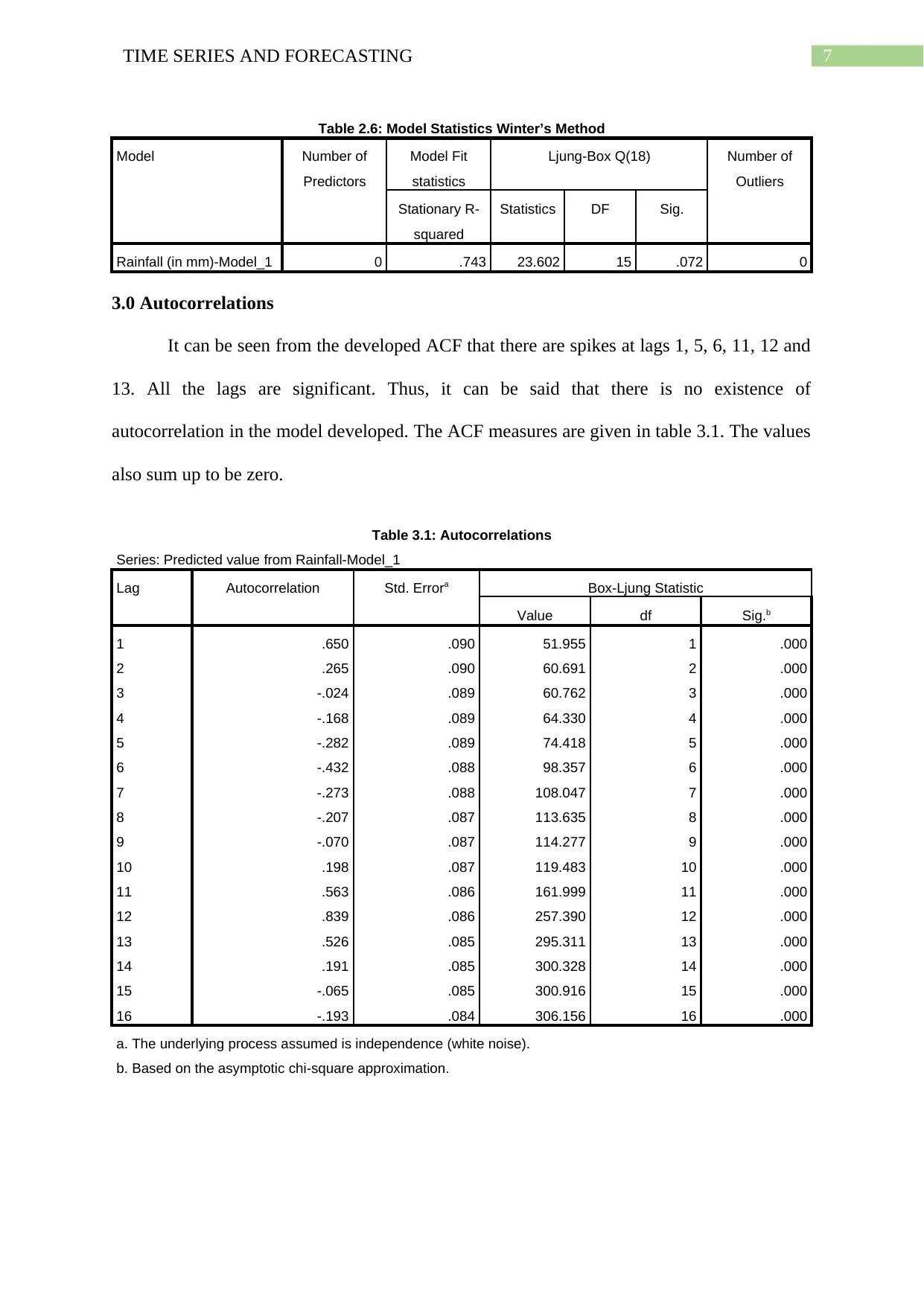
7TIME SERIES AND FORECASTING
Table 2.6: Model Statistics Winter’s Method
Model Number of
Predictors
Model Fit
statistics
Ljung-Box Q(18) Number of
Outliers
Stationary R-
squared
Statistics DF Sig.
Rainfall (in mm)-Model_1 0 .743 23.602 15 .072 0
3.0 Autocorrelations
It can be seen from the developed ACF that there are spikes at lags 1, 5, 6, 11, 12 and
13. All the lags are significant. Thus, it can be said that there is no existence of
autocorrelation in the model developed. The ACF measures are given in table 3.1. The values
also sum up to be zero.
Table 3.1: Autocorrelations
Series: Predicted value from Rainfall-Model_1
Lag Autocorrelation Std. Errora Box-Ljung Statistic
Value df Sig.b
1 .650 .090 51.955 1 .000
2 .265 .090 60.691 2 .000
3 -.024 .089 60.762 3 .000
4 -.168 .089 64.330 4 .000
5 -.282 .089 74.418 5 .000
6 -.432 .088 98.357 6 .000
7 -.273 .088 108.047 7 .000
8 -.207 .087 113.635 8 .000
9 -.070 .087 114.277 9 .000
10 .198 .087 119.483 10 .000
11 .563 .086 161.999 11 .000
12 .839 .086 257.390 12 .000
13 .526 .085 295.311 13 .000
14 .191 .085 300.328 14 .000
15 -.065 .085 300.916 15 .000
16 -.193 .084 306.156 16 .000
a. The underlying process assumed is independence (white noise).
b. Based on the asymptotic chi-square approximation.
Table 2.6: Model Statistics Winter’s Method
Model Number of
Predictors
Model Fit
statistics
Ljung-Box Q(18) Number of
Outliers
Stationary R-
squared
Statistics DF Sig.
Rainfall (in mm)-Model_1 0 .743 23.602 15 .072 0
3.0 Autocorrelations
It can be seen from the developed ACF that there are spikes at lags 1, 5, 6, 11, 12 and
13. All the lags are significant. Thus, it can be said that there is no existence of
autocorrelation in the model developed. The ACF measures are given in table 3.1. The values
also sum up to be zero.
Table 3.1: Autocorrelations
Series: Predicted value from Rainfall-Model_1
Lag Autocorrelation Std. Errora Box-Ljung Statistic
Value df Sig.b
1 .650 .090 51.955 1 .000
2 .265 .090 60.691 2 .000
3 -.024 .089 60.762 3 .000
4 -.168 .089 64.330 4 .000
5 -.282 .089 74.418 5 .000
6 -.432 .088 98.357 6 .000
7 -.273 .088 108.047 7 .000
8 -.207 .087 113.635 8 .000
9 -.070 .087 114.277 9 .000
10 .198 .087 119.483 10 .000
11 .563 .086 161.999 11 .000
12 .839 .086 257.390 12 .000
13 .526 .085 295.311 13 .000
14 .191 .085 300.328 14 .000
15 -.065 .085 300.916 15 .000
16 -.193 .084 306.156 16 .000
a. The underlying process assumed is independence (white noise).
b. Based on the asymptotic chi-square approximation.
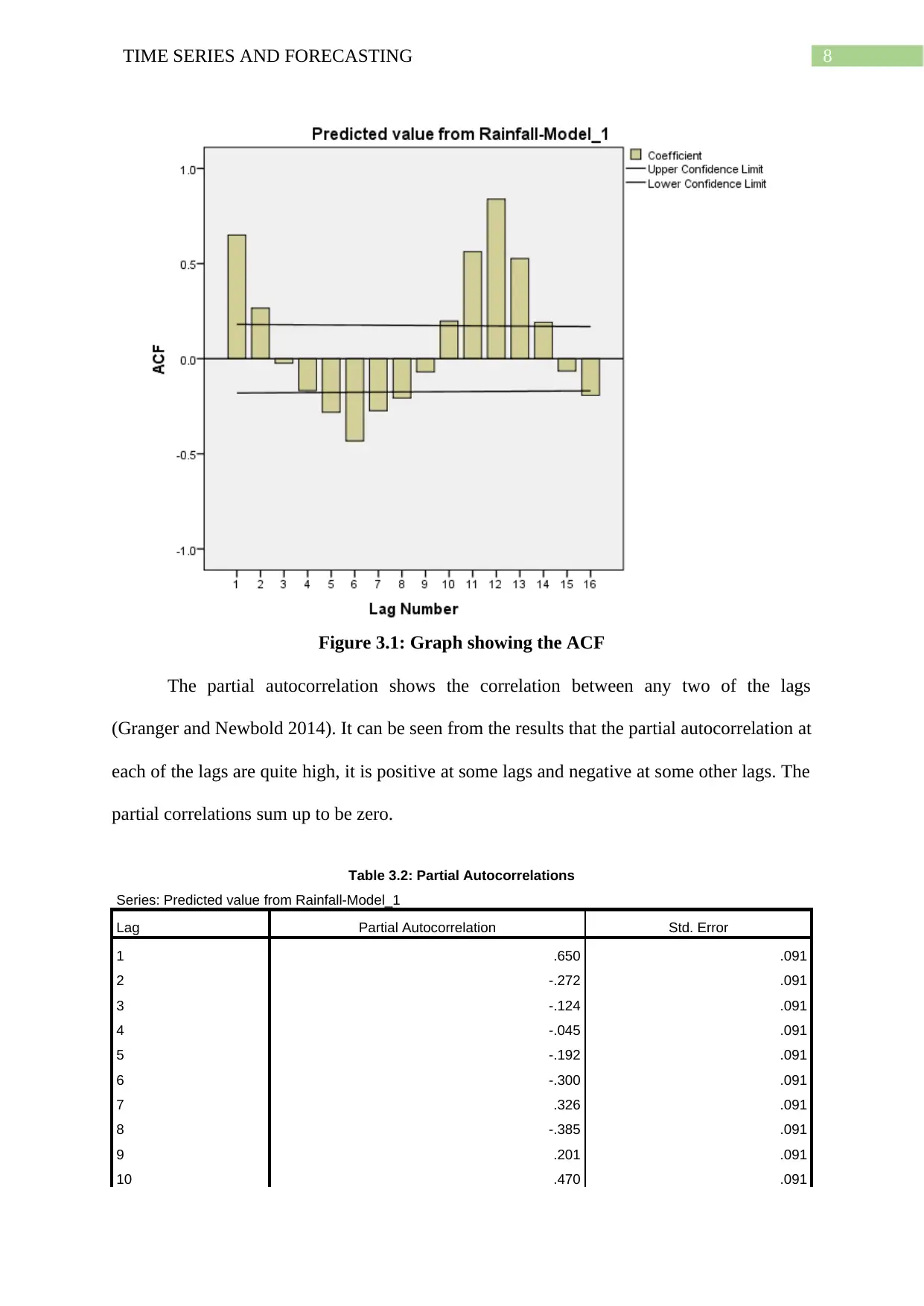
8TIME SERIES AND FORECASTING
Figure 3.1: Graph showing the ACF
The partial autocorrelation shows the correlation between any two of the lags
(Granger and Newbold 2014). It can be seen from the results that the partial autocorrelation at
each of the lags are quite high, it is positive at some lags and negative at some other lags. The
partial correlations sum up to be zero.
Table 3.2: Partial Autocorrelations
Series: Predicted value from Rainfall-Model_1
Lag Partial Autocorrelation Std. Error
1 .650 .091
2 -.272 .091
3 -.124 .091
4 -.045 .091
5 -.192 .091
6 -.300 .091
7 .326 .091
8 -.385 .091
9 .201 .091
10 .470 .091
Figure 3.1: Graph showing the ACF
The partial autocorrelation shows the correlation between any two of the lags
(Granger and Newbold 2014). It can be seen from the results that the partial autocorrelation at
each of the lags are quite high, it is positive at some lags and negative at some other lags. The
partial correlations sum up to be zero.
Table 3.2: Partial Autocorrelations
Series: Predicted value from Rainfall-Model_1
Lag Partial Autocorrelation Std. Error
1 .650 .091
2 -.272 .091
3 -.124 .091
4 -.045 .091
5 -.192 .091
6 -.300 .091
7 .326 .091
8 -.385 .091
9 .201 .091
10 .470 .091
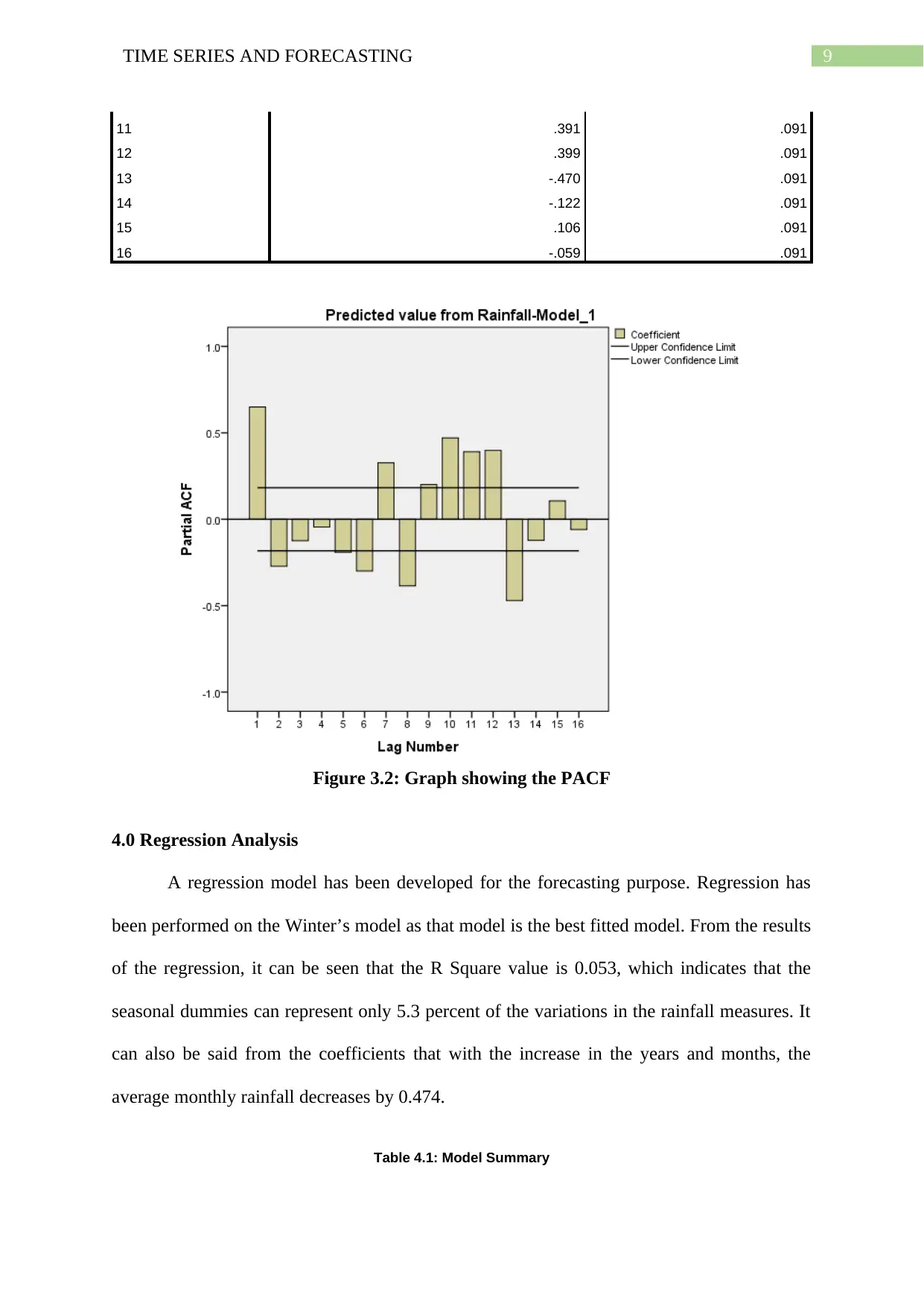
9TIME SERIES AND FORECASTING
11 .391 .091
12 .399 .091
13 -.470 .091
14 -.122 .091
15 .106 .091
16 -.059 .091
Figure 3.2: Graph showing the PACF
4.0 Regression Analysis
A regression model has been developed for the forecasting purpose. Regression has
been performed on the Winter’s model as that model is the best fitted model. From the results
of the regression, it can be seen that the R Square value is 0.053, which indicates that the
seasonal dummies can represent only 5.3 percent of the variations in the rainfall measures. It
can also be said from the coefficients that with the increase in the years and months, the
average monthly rainfall decreases by 0.474.
Table 4.1: Model Summary
11 .391 .091
12 .399 .091
13 -.470 .091
14 -.122 .091
15 .106 .091
16 -.059 .091
Figure 3.2: Graph showing the PACF
4.0 Regression Analysis
A regression model has been developed for the forecasting purpose. Regression has
been performed on the Winter’s model as that model is the best fitted model. From the results
of the regression, it can be seen that the R Square value is 0.053, which indicates that the
seasonal dummies can represent only 5.3 percent of the variations in the rainfall measures. It
can also be said from the coefficients that with the increase in the years and months, the
average monthly rainfall decreases by 0.474.
Table 4.1: Model Summary
Paraphrase This Document
Need a fresh take? Get an instant paraphrase of this document with our AI Paraphraser
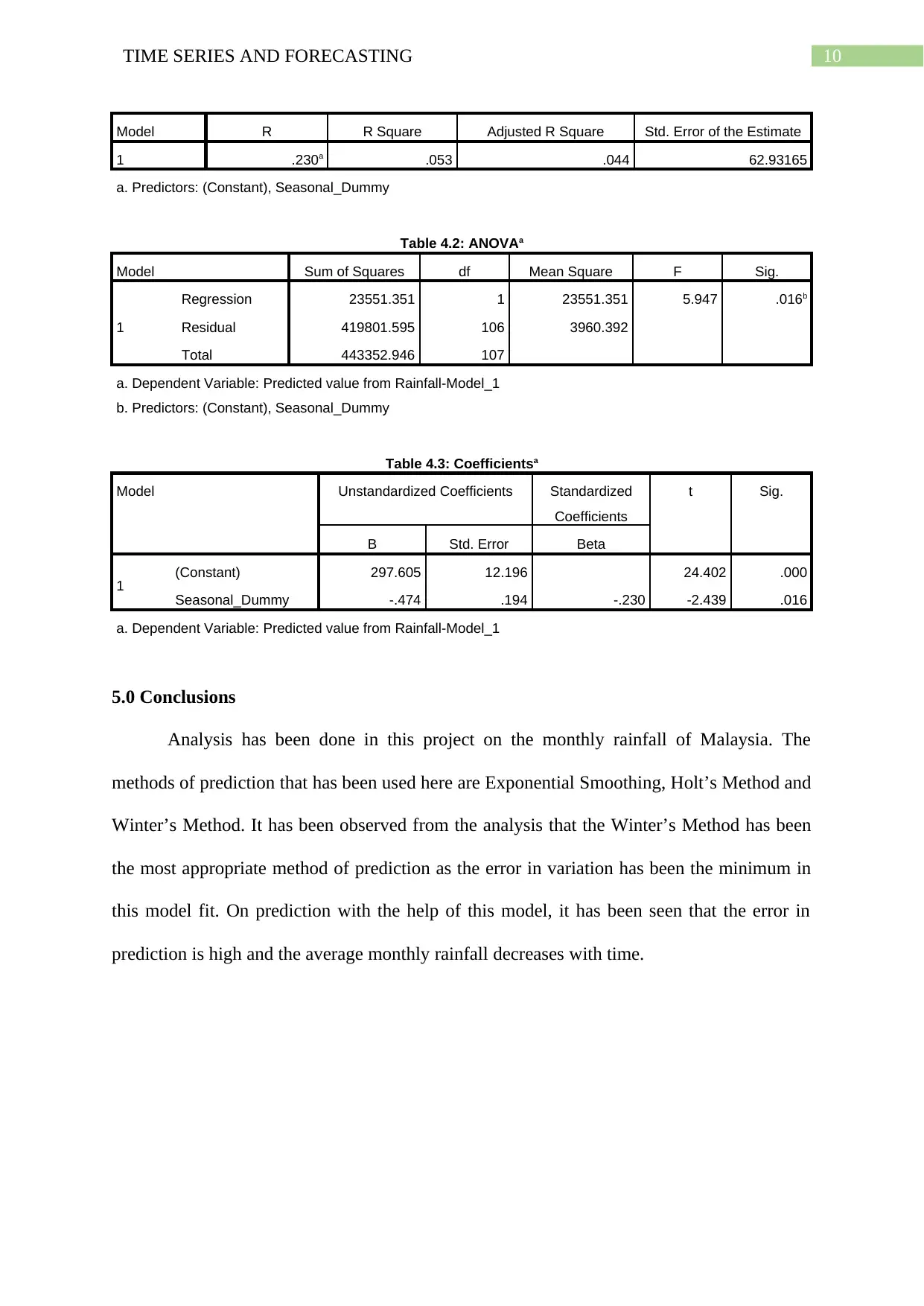
10TIME SERIES AND FORECASTING
Model R R Square Adjusted R Square Std. Error of the Estimate
1 .230a .053 .044 62.93165
a. Predictors: (Constant), Seasonal_Dummy
Table 4.2: ANOVAa
Model Sum of Squares df Mean Square F Sig.
1
Regression 23551.351 1 23551.351 5.947 .016b
Residual 419801.595 106 3960.392
Total 443352.946 107
a. Dependent Variable: Predicted value from Rainfall-Model_1
b. Predictors: (Constant), Seasonal_Dummy
Table 4.3: Coefficientsa
Model Unstandardized Coefficients Standardized
Coefficients
t Sig.
B Std. Error Beta
1 (Constant) 297.605 12.196 24.402 .000
Seasonal_Dummy -.474 .194 -.230 -2.439 .016
a. Dependent Variable: Predicted value from Rainfall-Model_1
5.0 Conclusions
Analysis has been done in this project on the monthly rainfall of Malaysia. The
methods of prediction that has been used here are Exponential Smoothing, Holt’s Method and
Winter’s Method. It has been observed from the analysis that the Winter’s Method has been
the most appropriate method of prediction as the error in variation has been the minimum in
this model fit. On prediction with the help of this model, it has been seen that the error in
prediction is high and the average monthly rainfall decreases with time.
Model R R Square Adjusted R Square Std. Error of the Estimate
1 .230a .053 .044 62.93165
a. Predictors: (Constant), Seasonal_Dummy
Table 4.2: ANOVAa
Model Sum of Squares df Mean Square F Sig.
1
Regression 23551.351 1 23551.351 5.947 .016b
Residual 419801.595 106 3960.392
Total 443352.946 107
a. Dependent Variable: Predicted value from Rainfall-Model_1
b. Predictors: (Constant), Seasonal_Dummy
Table 4.3: Coefficientsa
Model Unstandardized Coefficients Standardized
Coefficients
t Sig.
B Std. Error Beta
1 (Constant) 297.605 12.196 24.402 .000
Seasonal_Dummy -.474 .194 -.230 -2.439 .016
a. Dependent Variable: Predicted value from Rainfall-Model_1
5.0 Conclusions
Analysis has been done in this project on the monthly rainfall of Malaysia. The
methods of prediction that has been used here are Exponential Smoothing, Holt’s Method and
Winter’s Method. It has been observed from the analysis that the Winter’s Method has been
the most appropriate method of prediction as the error in variation has been the minimum in
this model fit. On prediction with the help of this model, it has been seen that the error in
prediction is high and the average monthly rainfall decreases with time.
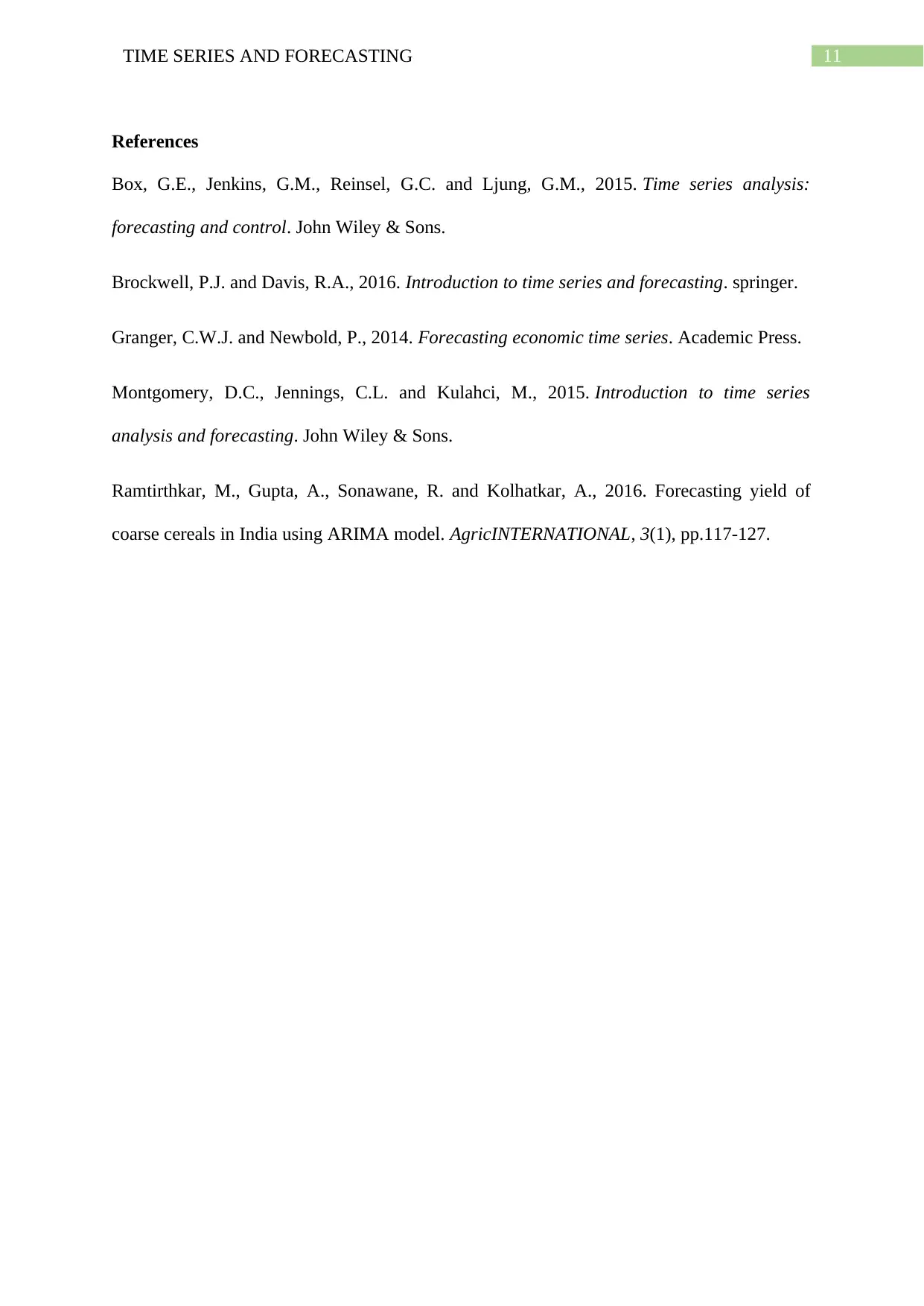
11TIME SERIES AND FORECASTING
References
Box, G.E., Jenkins, G.M., Reinsel, G.C. and Ljung, G.M., 2015. Time series analysis:
forecasting and control. John Wiley & Sons.
Brockwell, P.J. and Davis, R.A., 2016. Introduction to time series and forecasting. springer.
Granger, C.W.J. and Newbold, P., 2014. Forecasting economic time series. Academic Press.
Montgomery, D.C., Jennings, C.L. and Kulahci, M., 2015. Introduction to time series
analysis and forecasting. John Wiley & Sons.
Ramtirthkar, M., Gupta, A., Sonawane, R. and Kolhatkar, A., 2016. Forecasting yield of
coarse cereals in India using ARIMA model. AgricINTERNATIONAL, 3(1), pp.117-127.
References
Box, G.E., Jenkins, G.M., Reinsel, G.C. and Ljung, G.M., 2015. Time series analysis:
forecasting and control. John Wiley & Sons.
Brockwell, P.J. and Davis, R.A., 2016. Introduction to time series and forecasting. springer.
Granger, C.W.J. and Newbold, P., 2014. Forecasting economic time series. Academic Press.
Montgomery, D.C., Jennings, C.L. and Kulahci, M., 2015. Introduction to time series
analysis and forecasting. John Wiley & Sons.
Ramtirthkar, M., Gupta, A., Sonawane, R. and Kolhatkar, A., 2016. Forecasting yield of
coarse cereals in India using ARIMA model. AgricINTERNATIONAL, 3(1), pp.117-127.
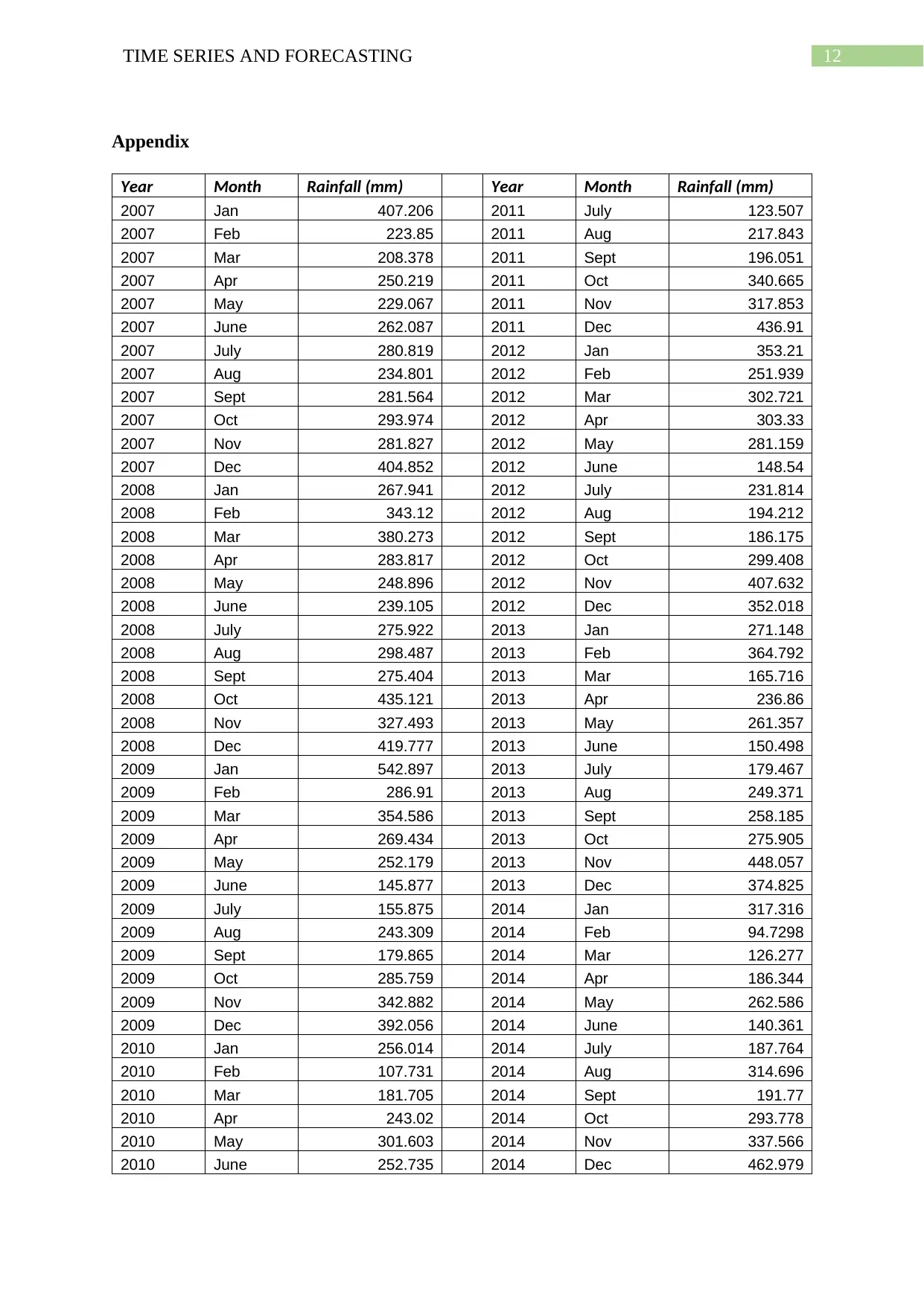
12TIME SERIES AND FORECASTING
Appendix
Year Month Rainfall (mm) Year Month Rainfall (mm)
2007 Jan 407.206 2011 July 123.507
2007 Feb 223.85 2011 Aug 217.843
2007 Mar 208.378 2011 Sept 196.051
2007 Apr 250.219 2011 Oct 340.665
2007 May 229.067 2011 Nov 317.853
2007 June 262.087 2011 Dec 436.91
2007 July 280.819 2012 Jan 353.21
2007 Aug 234.801 2012 Feb 251.939
2007 Sept 281.564 2012 Mar 302.721
2007 Oct 293.974 2012 Apr 303.33
2007 Nov 281.827 2012 May 281.159
2007 Dec 404.852 2012 June 148.54
2008 Jan 267.941 2012 July 231.814
2008 Feb 343.12 2012 Aug 194.212
2008 Mar 380.273 2012 Sept 186.175
2008 Apr 283.817 2012 Oct 299.408
2008 May 248.896 2012 Nov 407.632
2008 June 239.105 2012 Dec 352.018
2008 July 275.922 2013 Jan 271.148
2008 Aug 298.487 2013 Feb 364.792
2008 Sept 275.404 2013 Mar 165.716
2008 Oct 435.121 2013 Apr 236.86
2008 Nov 327.493 2013 May 261.357
2008 Dec 419.777 2013 June 150.498
2009 Jan 542.897 2013 July 179.467
2009 Feb 286.91 2013 Aug 249.371
2009 Mar 354.586 2013 Sept 258.185
2009 Apr 269.434 2013 Oct 275.905
2009 May 252.179 2013 Nov 448.057
2009 June 145.877 2013 Dec 374.825
2009 July 155.875 2014 Jan 317.316
2009 Aug 243.309 2014 Feb 94.7298
2009 Sept 179.865 2014 Mar 126.277
2009 Oct 285.759 2014 Apr 186.344
2009 Nov 342.882 2014 May 262.586
2009 Dec 392.056 2014 June 140.361
2010 Jan 256.014 2014 July 187.764
2010 Feb 107.731 2014 Aug 314.696
2010 Mar 181.705 2014 Sept 191.77
2010 Apr 243.02 2014 Oct 293.778
2010 May 301.603 2014 Nov 337.566
2010 June 252.735 2014 Dec 462.979
Appendix
Year Month Rainfall (mm) Year Month Rainfall (mm)
2007 Jan 407.206 2011 July 123.507
2007 Feb 223.85 2011 Aug 217.843
2007 Mar 208.378 2011 Sept 196.051
2007 Apr 250.219 2011 Oct 340.665
2007 May 229.067 2011 Nov 317.853
2007 June 262.087 2011 Dec 436.91
2007 July 280.819 2012 Jan 353.21
2007 Aug 234.801 2012 Feb 251.939
2007 Sept 281.564 2012 Mar 302.721
2007 Oct 293.974 2012 Apr 303.33
2007 Nov 281.827 2012 May 281.159
2007 Dec 404.852 2012 June 148.54
2008 Jan 267.941 2012 July 231.814
2008 Feb 343.12 2012 Aug 194.212
2008 Mar 380.273 2012 Sept 186.175
2008 Apr 283.817 2012 Oct 299.408
2008 May 248.896 2012 Nov 407.632
2008 June 239.105 2012 Dec 352.018
2008 July 275.922 2013 Jan 271.148
2008 Aug 298.487 2013 Feb 364.792
2008 Sept 275.404 2013 Mar 165.716
2008 Oct 435.121 2013 Apr 236.86
2008 Nov 327.493 2013 May 261.357
2008 Dec 419.777 2013 June 150.498
2009 Jan 542.897 2013 July 179.467
2009 Feb 286.91 2013 Aug 249.371
2009 Mar 354.586 2013 Sept 258.185
2009 Apr 269.434 2013 Oct 275.905
2009 May 252.179 2013 Nov 448.057
2009 June 145.877 2013 Dec 374.825
2009 July 155.875 2014 Jan 317.316
2009 Aug 243.309 2014 Feb 94.7298
2009 Sept 179.865 2014 Mar 126.277
2009 Oct 285.759 2014 Apr 186.344
2009 Nov 342.882 2014 May 262.586
2009 Dec 392.056 2014 June 140.361
2010 Jan 256.014 2014 July 187.764
2010 Feb 107.731 2014 Aug 314.696
2010 Mar 181.705 2014 Sept 191.77
2010 Apr 243.02 2014 Oct 293.778
2010 May 301.603 2014 Nov 337.566
2010 June 252.735 2014 Dec 462.979
Secure Best Marks with AI Grader
Need help grading? Try our AI Grader for instant feedback on your assignments.

13TIME SERIES AND FORECASTING
2010 July 286.155 2015 Jan 327.939
2010 Aug 287.222 2015 Feb 148.93
2010 Sept 291.476 2015 Mar 118.765
2010 Oct 229.819 2015 Apr 231.605
2010 Nov 352.07 2015 May 202.378
2010 Dec 380.536 2015 June 210.088
2011 Jan 447.97 2015 July 135.85
2011 Feb 262.378 2015 Aug 232.627
2011 Mar 409.674 2015 Sept 155.673
2011 Apr 207.477 2015 Oct 218.301
2011 May 272.84 2015 Nov 366.935
2011 June 244.528 2015 Dec 306.581
2010 July 286.155 2015 Jan 327.939
2010 Aug 287.222 2015 Feb 148.93
2010 Sept 291.476 2015 Mar 118.765
2010 Oct 229.819 2015 Apr 231.605
2010 Nov 352.07 2015 May 202.378
2010 Dec 380.536 2015 June 210.088
2011 Jan 447.97 2015 July 135.85
2011 Feb 262.378 2015 Aug 232.627
2011 Mar 409.674 2015 Sept 155.673
2011 Apr 207.477 2015 Oct 218.301
2011 May 272.84 2015 Nov 366.935
2011 June 244.528 2015 Dec 306.581
1 out of 14
![[object Object]](/_next/static/media/star-bottom.7253800d.svg)




